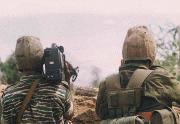


 Two
LTTE men: "trying to pin down the army"
Two
LTTE men: "trying to pin down the army"
The Liberation Tigers
say in the latest issue of their official organ ‘Viduthalai Pulihal’
that the army wants to draw them widely into battles and thereby destroy their
power of resistance by opening several fronts simultaneously in the ongoing
Vanni war .
It appears from what they say in ‘Viduthalai Pulihal’ they want to do the same to the army.
Can they do it ?
Achieving this means three things. One is to keep their current military strength intact-preserving all their military assets. Two is to keep up or even improve their recruitment levels in the north and east; and three is to have the army spread thin and pinned down to a comparatively small part of the Vanni.
Now let us see how they can fare in each.
1). Their statement in ‘Viduthalai Pulihal’ leaves no doubt as to their intention preserving their military assets intact as they did during Riviresa I. At that time they had the Vanni completely to themselves into which they could withdraw with all their military resources.
Now, they clearly do not intend shifting to the East although there is some evidence that more of their heavy weapons may be transferred to the Batticaloa and Muthur regions.
Although the army says it wants to secure both eastern and western hinterlands of the Vavuniya Kilinochchi road, the concentration of forces is apparently on the east of it.
Even if Jayasikurui succeeds in its final phase, the western sector of the Vanni will remain largely in the hands of the LTTE.
And also dominating all the dense jungles of eastern Mullaithivu is an impossible task-the Indian army discovered this only when it was time for it to leave. (The Army however insists now that it is not intelligence blind in the Vanni and hence has a clear advantage)
Part of the LTTE’s military strength can be relocated in the vast jungle zone south of the Medawachchiya-Mannar road. There are indications that the process has already begun. This region is strategically similar to the eastern Mullaithivu in that it gives safe access to international waters and has a forest covered hinterland which lies close to the beaches. The LTTE discovered and developed the strategic potential of this area in late 1992. The threat to the west coast will then increase greatly.
The LTTE can keep up its current recruitment level and even be improve it as long as most Tamil areas of the east remain in its hands. It has also ample area to train and maintain a large number of troops both in the east and the south western part of the Vanni. In the eastern province the Liberation Tigers have at least three thousand sq. kilometers for this purpose.
3). Keeping the Army spread thin and having it pinned down to relatively small theatre of operation is clearly the LTTE’s motive in the Vanni war.
The army is on the Mankulam-Ottisuddan road now at Karippatta Murippu. The jungles east of Kanakarayan Kulam are dotted with army camps. However, the LTTE is trying its best to prevent the army from taking Puliyankulam, Kanakarayan Kulam and Mankulam. The position of the LTTE and the troops of Div. 53 are at very close range at Karippatta Murippu as they are at Puliyankulam junction.
At the same time the LTTE is thwarting attempts by Div.55 from spreading itself towards the western sector of Mankulam. The LTTE’s objective in doing this is to draw the army in large numbers into the Vanni jungles and then pin it down by preventing it from clinching its strategic goals-Puliyankulam, Mankulam or Ottisuddan.
The army’s strength in Jayasikurui has been heavily beefed up by the addition of a new division.
There are now three full strength divisions in the Vanni theatre. The new unit is Div.56. It is an infantry division which was raised last month.
Div.56 is commanded by Brigadier. Sunil Chandrapala.
Although normally an army division on the average consists of fifteen thousand soldiers, the Sri Lankan army divisions that are deployed in the war zone have only about nine thousand troops each.
This is so because brigades in the Sri Lankan army have just two battalions each instead of three which is standard. (Three brigades form a division). The army has deployed Div.51 and 52 in the Jaffna peninsula along with two Task Force (TF) groups. Task Force One has its headquarters at Palaly and TF Two has its HQ at Elephant Pass. Trincomalee is under TF Three.
The brunt of Jayasikurui’s second phase was borne by the elite Div. 53 consisting of 53-1 air mobile unit, the 53-2 Independent brigade of Special Forces commandos, 53-3 of special armour and the infantry of 53-4.
If we consider the geographical size of the area in which Div.55, Div. 56 and Div. 53 are concentrated it will be clear that unless the army secures either Mankulam, Kanakarayan Kulam or for that matter even Ottisuddan in the initial stages of Jayasikurui’s final thrust to Kilinochchi, the LTTE can easily achieve its objective of catching the army in its own trap.
It has been raining mortar and artillery fire on the army’s positions captured in the second phase of Jayasikurui. There have been several direct attacks and ambushes as well in the region where the three divisions are concentrated now.
Harassing and wearing down a significant portion of the army’s will and strength within a manageably sized theatre of operations in the Vanni is the primary concern of the LTTE now.
Circumventing the Tiger trap while opening and holding the main supply route (MSR) to Jaffna is a Catch 22 situation for the Army as long as the LTTE keeps all its military assets secure.
Go to Rajpal Abeynayake's Column
Return to the Editorial/Opinion contents page
